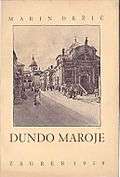Dundo Maroje
Dundo Maroje (lit. "Uncle Maroje")[1] is a comedy by Croatian playwright Marin Držić. It is said to have been first performed in 1551 in the main hall of the Grand Council of the Republic of Ragusa by the company Pomet.[2] The play consists of two prologues and five acts (ending did not survive). The story deals with a conflict and misunderstandings between the older and newer generations during the Renaissance. The play takes place in Rome, but its characters are from Dubrovnik.[3] George Thomas, a professor at McMaster University wrote that it is the author's "best-known work" and "the most enduring work in the history of Croatian drama".[3] Renato Kragić of Slobodna Dalmacija describes Dundo Maroje as "among the top of dramatic literature in Croatian language" and that "should be in the pantheon of European Renaissance literature"[4] Ante Kadić wrote in Slavic Review about Dundo Maroje being Držić's main work. (need detail inside this book)[5]

Notable adaptations and presentations

In 2008, International Federation of Library Associations and Institutions (IFLA) reported that Dundo Maroje had been translated to 18 languages.[6]
In March 2018, Filip Krenus and a group of actors did a reading of the play as translated by his team in English at Conway Hall in London for the 450th anniversary of Držić's death.[7] In November 2018, an English-translated performance of the play took place at the European Parliament in Brussels.[8]
References
- Thomas, David; Chesworth, John A. (eds.). Central and Eastern Europe, Asia, Africa and South America (1500-1600) – Marin Držić. Christian-Muslim Relations. A Bibliographical History. 7. Leiden, The Netherlands: Koninklijke Brill NV. p. 270-271. ISBN 978-9004298484.
- Gassner, John; Quinn, Edward, eds. (2002). The Reader's Encyclopedia of World Drama. Dover books on cinema and the stage. Courier Corporation. p. 930. ISBN 9780486420646.
- Thomas, George (2000). "A Diachronic Approach to Sociolinguistics: Language use of selected plays in Croatia". In Tomic, Olga Miseska; Radovanovic, Milorad (eds.). History and Perspectives of Language Study: Papers in Honor of Ranko Bugarski. Amsterdam Studies in the Theory and History of Linguistic Science. 186. John Benjamins Publishing. pp. 235–253. ISBN 9789027236920.
- Kragić, Renato (9 September 2011). "Novac, seks, iće i piće:" [Money, sex, drinks and drinks: "Dundo Maroje" in Gavelli]. Slobodna Dalmacija (in Croatian). Retrieved 27 February 2019.
- Kadic, Ante (March 1962). "The Croatian Renaissance". Slavic Review. American Association for the Advancement of Slavic Studies. 21 (1): 83–84. doi:10.2307/3000544.
- "IFLA National Libraries Section Newsletter" (PDF). International Federation of Library Associations and Institutions. December 2008. p. 7. Retrieved 26 February 2019.
- Simmonds, Lauren (5 March 2018). "Marin Držić Presented in London!". Total Croatia News. Retrieved 27 February 2019.
- ""Dundo Maroje" na engleskom predstavljen u Bruxellesu" ["Dundo Maroje" in English, presented in Brussels]. Dubrovnik.net (in Croatian). 21 November 2018. Retrieved 27 February 2019.
| Croatian Wikisource has original text related to this article: |